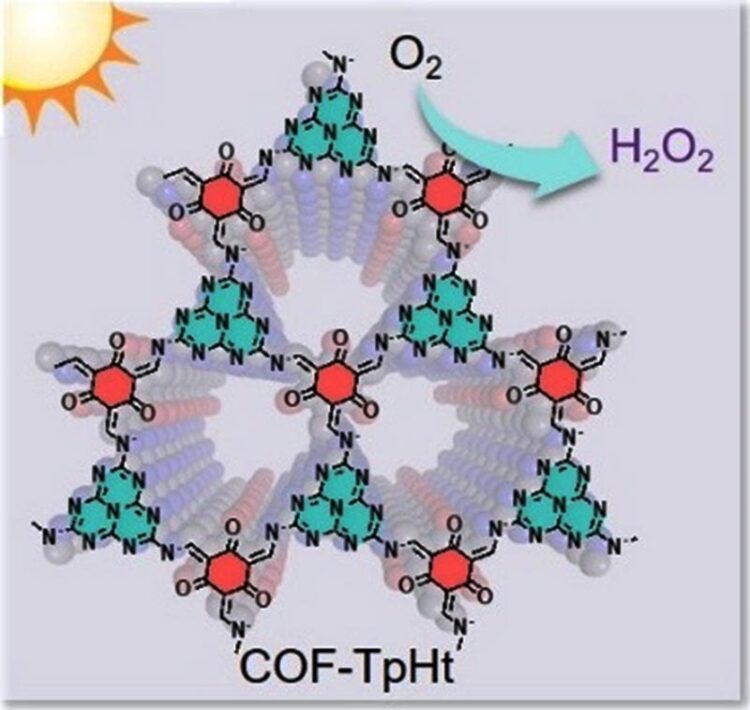A covalent organic framework

Inspired by the inherent merits and pitfalls of C3N4, a novel structural design strategy was proposed by assembling heptazine motifs into crystalline 2D covalent heptazine frameworks. The resultant materials exhibit an ultrahigh H2O2 production rate of 11986 μmol h–1 g–1 (52 times higher than that of pristine C3N4) and an AQY of 38% at 420 nm. Impressively, a rarely attainable H2O2 concentration of over 59 mM was also achieved after a long time reaction.
Credit: Chinese Journal of Catalysis
… inspired by C3N4 for photosynthesis of hydrogen peroxide with high quantum efficiency.
H2O2 is not only a green oxidant that widely used in environmental remediation, industrial synthesis, and medical healthcare, etc., but also an emerging energy carrier with a high energy density comparable to compressed H2. At present, anthraquinone oxidation is still the primary route for large-scale H2O2 production, which requires a high energy input and creates a lot of harmful pollutants.
As an alternative, photosynthesis of H2O2 from water and O2 has been considered as a green, safe, and energy-saving strategy for sustainable H2O2 production, and has attracted growing interest over the past years. However, the photocatalytic efficiency is still far from meeting the practical requirements. The exploration of efficient semiconductor photocatalysts with superior optoelectronic properties is the key to achieving desirable photocatalytic performance.
Among many candidates, carbon nitride (C3N4) has been the main research focus for photocatalytic H2O2 synthesis. Specially, the heptazine units in C3N4 play a critical role of active sites to facilitate the selective oxygen reduction. Moreover, the metal-free nature of C3N4 could also protect the generated H2O2 from fast decomposition caused by transition-metal sites like in inorganic semiconductors. However, C3N4 photocatalysts usually suffer from narrow light absorption and fast charge recombination due to insufficient conjugation, leading to unsatisfactory photocatalytic performance.
On the basis of the understanding of the inherent merits and pitfalls of C3N4, Prof. Yanguang Li from Soochow University, China and his coworkers proposed a new photocatalyst design strategy that integrating the active heptazine units and functional linkers into crystalline conjugated polymer frameworks. The highly conjugated molecular structure could improve the electron delocalization thorough the organic skeletons and increase the light absorption; furthermore, the ordered interlayer π-π would provide high-speed channels for charge transfer, thereby decreasing their recombination.
By comparison with the pristine C3N4, the resultant sample (denoted as COF-TpHt) exhibits a broader light absorption up to 800 nm and much improved charge separation efficiency as demonstrated by a series of spectroscopic measurements. Under the visible-light irradiation, COF-TpHt exhibits a high H2O2 production rate of 11986 μmol h–1 g–1 and an apparent quantum efficiency (AQE) up to 38% at 420 nm, both of which are superior to other reported organic and inorganic counterparts. Impressively, COF-TpHt shows excellent stability that enables almost linear H2O2 accumulation during a long time irradiation, giving rise to a H2O2 concentration of over 59 mM after 30 h. This research has been published in Chinese Journal of Catalysis (https://doi.org/10.1016/S1872-2067(22)64205-0).
This work was supported by the National Natural Science Foundation of China (22002100, U2002213), the Natural Science Foundation of Jiangsu Province (BK20220027), Collaborative Innovation Center of Suzhou Nano Science and Technology, the 111 Project and Joint International Research Laboratory of Carbon‐Based Functional Materials and Devices.
About the Journal
Chinese Journal of Catalysis is co-sponsored by Dalian Institute of Chemical Physics, Chinese Academy of Sciences and Chinese Chemical Society, and it is currently published by Elsevier group. This monthly journal publishes in English timely contributions of original and rigorously reviewed manuscripts covering all areas of catalysis. The journal publishes Reviews, Accounts, Communications, Articles, Highlights, Perspectives, and Viewpoints of highly scientific values that help understanding and defining of new concepts in both fundamental issues and practical applications of catalysis. Chinese Journal of Catalysis ranks among the top two journals in Applied Chemistry with a current SCI impact factor of 12.92. The Editors-in-Chief are Profs. Can Li and Tao Zhang.
At Elsevier http://www.journals.elsevier.com/chinese-journal-of-catalysis
Manuscript submission https://mc03.manuscriptcentral.com/cjcatal
Media Contact
Fan He
Dalian Institute of Chemical Physics, Chinese Academy Sciences
hef197@dicp.ac.cn
Office: 86-411-843-79240
All latest news from the category: Life Sciences and Chemistry
Articles and reports from the Life Sciences and chemistry area deal with applied and basic research into modern biology, chemistry and human medicine.
Valuable information can be found on a range of life sciences fields including bacteriology, biochemistry, bionics, bioinformatics, biophysics, biotechnology, genetics, geobotany, human biology, marine biology, microbiology, molecular biology, cellular biology, zoology, bioinorganic chemistry, microchemistry and environmental chemistry.
Newest articles

NASA: Mystery of life’s handedness deepens
The mystery of why life uses molecules with specific orientations has deepened with a NASA-funded discovery that RNA — a key molecule thought to have potentially held the instructions for…

What are the effects of historic lithium mining on water quality?
Study reveals low levels of common contaminants but high levels of other elements in waters associated with an abandoned lithium mine. Lithium ore and mining waste from a historic lithium…

Quantum-inspired design boosts efficiency of heat-to-electricity conversion
Rice engineers take unconventional route to improving thermophotovoltaic systems. Researchers at Rice University have found a new way to improve a key element of thermophotovoltaic (TPV) systems, which convert heat…



